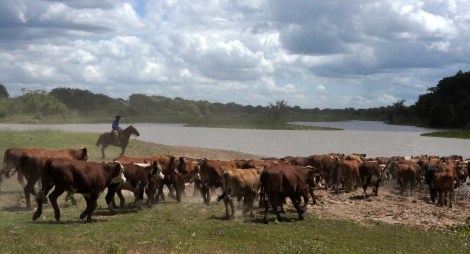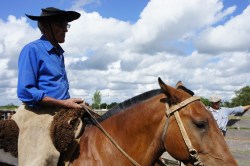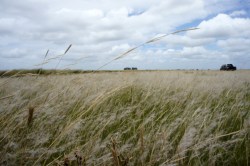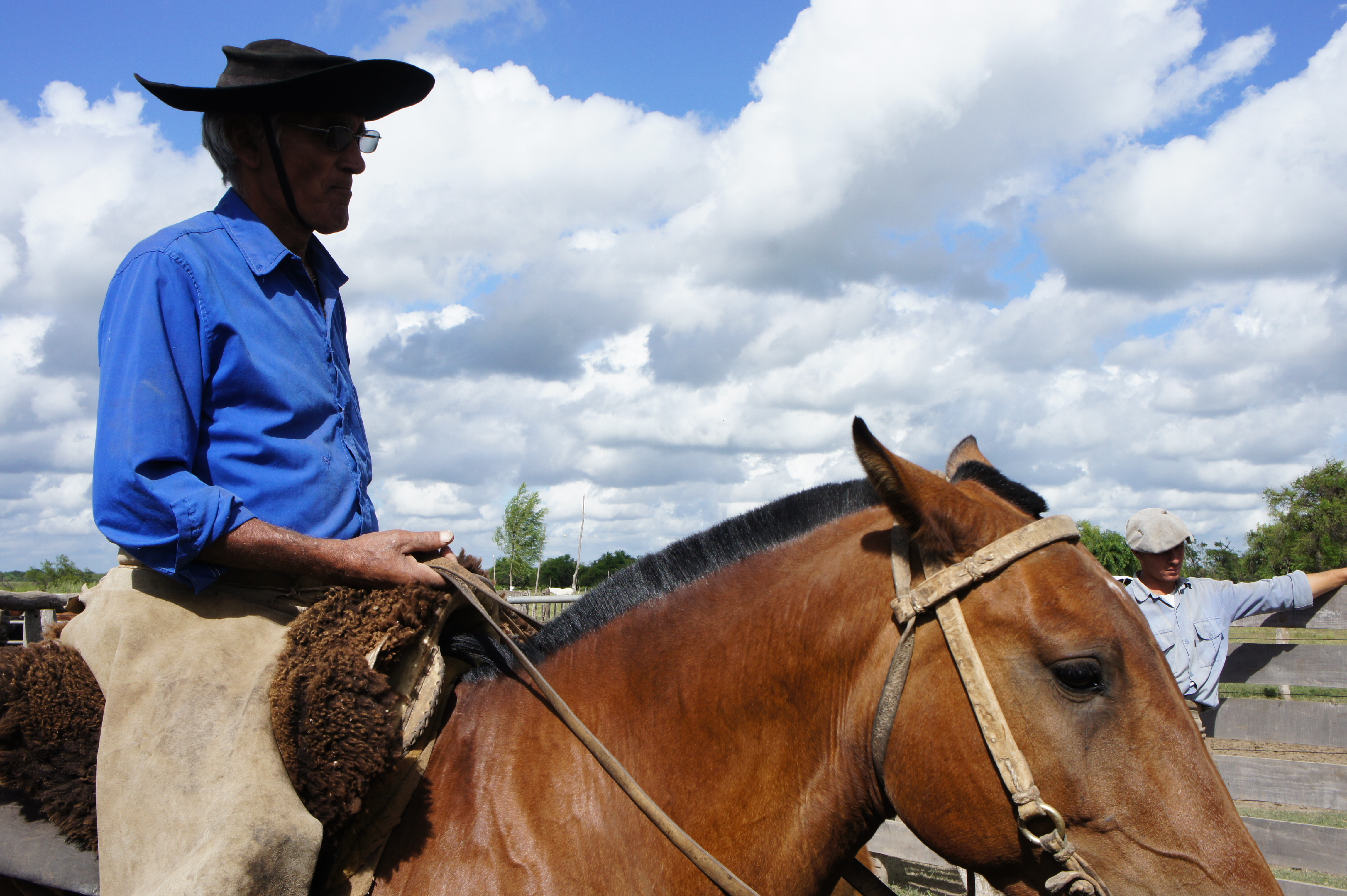
Estancia Ranch, one of few remaining traditional pasture-based ranches in Argentina. (All photos by Jessica Weiss.)
Buenos Aires, Argentina: It’s no secret the people here love beef.
In 1958, the average Argentine consumed 216 pounds of it per year. (For context: U.S. beef consumption peaked in 1975 at 89 pounds per person.) Argentina was once the world’s fifth largest economy, due largely to the strength of its global dominance in the beef trade. Because of a grand confluence of factors including climate and natural grass diversity, Argentina was long known as a hungry cow’s heaven — and the arbiter of the world’s best beef.
But today, much of the country’s famous grasslands have been turned over to crops. Beef consumption and exports are way down. And lest you think it’s because overall meat consumption is down, irony would have it that Argentina is now the world’s No. 1 exporter of soymeal, No. 2 of corn, and No. 3 of soybeans, increasingly used as animal feed in China, where meat-eating is through the roof.
Images of cows on pasture are still common in Argentina’s guidebooks and on postcards and butcher shop windows, but cattle production now largely relies on the feedlot. As a result, a small but growing movement of consumers, providers, and environmentalists is beginning to demand the beef of days past.
The “grass” was always implied
Many scientists agree that meat consumption is intrinsically tied to climate change. And beef, lamb, and other methane-emitting ruminant animals are said to be responsible for a large portion of the greenhouse gases caused by food production. One recent study also concluded that people in the developed world must cut the amount of meat they eat in half to reduce emissions of nitrous oxide (N2O), a potent greenhouse gas.
But in Argentina, conservationists argue that raising beef on natural grasslands is a sustainable tradition, and much better suited to the biodiversity of the grassland, called “the Pampas,” than industrial row-crop agriculture and feedlots.
Just 20 years ago, virtually all of Argentina’s cows still grazed freely. But as global agriculture markets boomed, it became harder for cattle farmers to resist the quick profit from soy, wheat, and corn. Hastened by a major financial crisis in 2001, many cattle ranchers sold their cows and turned over their land. Whereas grass-fed cows may take three to five years to be ready to sell, a farmer can turn around a soy or corn crop in a matter of months.
“Basically, cow production got pushed out of the Argentine Pampas,” says Ricardo Sager, director of scientific and technological development at Argentina’s National Institute of Agricultural Technology (INTA).
To keep beef prices low on less land, the Argentine government developed legislation in the late 1990s that provided subsidies for the corn-fed to feedlot cows. Both INTA and the Argentine Beef Promotion Institute touted use of the feedlot for quick, effective production. Now, much of the country’s beef — up to 80 percent by some estimates — has been through a feedlot.
Argentine cultural ties to beef remain strong. And by most standards, Argentines still eat an enormous amount of it — an average 118 pounds per person in 2011.
“Meat in Argentina is a strategic food,” Sager says. “Like rice in Asia and corn in Mexico, everyone has to have access and it has to be cheap.”

A gaucho, or Argentinian cowboy.
Not everyone sees it that way. At one farm in Entre Rios, Argentina, ranchers are trying to turn Sager’s argument on its head, by contributing to the creation of a premium for beef for the first time ever in Argentina’s history.
There, on 65,000 acres alongside the Paraná River, 20,000 cows graze without being bothered by humans. The herd, owned by Estancia Grass Fed Beef, is one of the largest pasture-raised herds of steer in the world.
“We’re essentially working in the traditional Argentine model,” says J.P. Thieriot, the co-founder of Estancia, “which not long ago was a model for sustainable farming.”
That model, he explains, involves grazing and fertilizing by free-range cattle for five to seven years, until the ground is primed for a short (one- to two-year) crop cycle.
“Such a system is essentially eternally sustainable,” he says.
Thieriot grew up on cattle farms in Argentina and California. He says Argentina and Uruguay are really the only places in the world where it’s possible to raise such a high volume of top quality cows year round, due to the temperate climate, access to water sources, and expansive, rich grasslands. Estancia’s animals are never given antibiotics nor hormones; the soil never sees pesticides or fertilizer. The company employs local ranchers and uses innovative animal welfare techniques.
Next he’s working on branding the product. “Creating recognition will eventually create a demand, which will create a price premium,” Thieriot says, “which will make it more compelling for Argentine ranchers to keep or add cattle — instead of getting rid of them to plant wall-to-wall soy.”
Estancia sells three main, prime cuts to high-end markets and restaurants overseas: tenderloin, rib eye, and New York strip. The rest of the cow (the majority of it) enters Argentina’s domestic market, where it is sold alongside beef from a feedlot, for the same price. But there is no labeling, grading or certification infrastructure in place for meat. All farmers sell in the same market.
“So basically, customers at a grocery store in Buenos Aires are buying Estancia’s beef without knowing it,” Thieriot says. “It’s completely unlabeled.”
Some Buenos Aires chefs intentionally serve grass-fed beef, however. And customers in good relation with their butchers may be able to get it, too. But the vast majority of consumers pay no attention to the overall tenderness or distribution or color of fat, for instance, which are telltale ways to distinguish feedlot versus grass-fed. In Argentina, grass-fed beef has never needed a title or a label — the “grass” was always implied — and it’s unlikely that many consumers are aware of the difference.

Many acres of the Pampas, a traditional grassland, have been cultivated to grow industrial-scale soy.
A threatened ecosystem
Plans are in the works for the first-ever label for grass-fed beef in Argentina, which will be available this year in select towns, starting with certification of 35 farms. It’s being spearheaded by Aves Argentinas (Argentine Birds), a wildlife organization that is part of an alliance to save Argentina’s grasslands, in partnership with Fundación Vida Silvestre (The Wildlife Foundation of Argentina).
“The label will signify what we like to call ‘grassland beef,’” says conservationist Gustavo Marino, who works with Aves Argentinas. “This means meat from farms that conserve grasslands and their biodiversity.”
Cows must be fed and raised on native grasslands, with feedlot usage prohibited. To receive certification, farms will have to be registered with the Alliance and adhere to a variety of protocols.
“The idea is to offer consumers the option for a product that contributes to saving a threatened ecosystem,” Marino says.
The Pampas is one of the richest areas of grassland biodiversity in the world, with up to 200 species of grass per hectare. Historically, these grasses have attracted hundreds of species of birds and other wildlife unique to the area. But with the intensification of agriculture, this biodiversity is disappearing, Marino says.
The alliance is also working with 18 ranchers throughout the country to introduce best practices for maximizing production while promoting biodiversity, in a project funded by the Global Environment Facility and the World Bank. A pocket-sized guide to the birds and grasses of the Pampas is distributed to farmers, so that “rural producers can recognize the animals and nature of their environments.”
The challenge ahead: creating demand
Some say the creation of a premium product faces a steep uphill battle.
“For farmers, once land is converted to grain, it is a difficult proposition to revert back to pasture,” says Mike Skowronek, an American rancher in Buenos Aires.
“A soy farmer, for example, would have to skip a harvest payday to buy new cows and wait for his grass to re-grow.”
Skowronek says he’s perhaps the only rancher still committed to the grass-fed method in Tapalqué, in the middle of Buenos Aires province and once the heartland of free-range cattle. He blogs extensively about the challenges that come with grass-fed farming in modern-day Argentina.
But Marino says he is confident demand will grow the more people learn.
“Of course we’re going to have to get them interested because of the flavor first,” he says, “and then educate them about the other reasons to choose grass-fed.”




